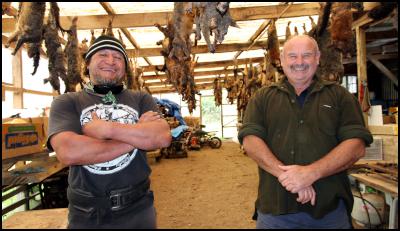Portable hut for Warawara Forest guardians
Portable hut for Warawara Forest guardians

A hardy group of possum trappers whose work requires them to camp out in the remote Hokianga forest they are working to protect have been gifted use of a $13,000 portable hut to make their jobs a little easier.
The Northland Regional Council approved the purchase of the 10 square metre hut recently to help those behind the ‘Warawara Whakaora Ake’project, which aims to rid the roughly 12,000 hectare Warawara Forest of possums and other pests.
Kane McElrea, the regional council’s Biosecurity Projects Manager, says the rugged forest involved is a roughly 50-50 spilt of private and co-managed public land and the project is developing into a real success story.
“Since control work began in earnest about 18 months ago, possum and rat numbers have been significantly reduced and those involved are now starting to see the forest beginning to recover.”
Mr McElrea says all nine marae surrounding the forest are driving the project, supported by Te Runanga o Te Rarawa.
“This partnership also extends to a range of other players including the council, Reconnecting Northland (an ecological restoration collaboration between WWF-New Zealand and NZ Landcare Trust), the Department of Conservation and Nga Whenua Rahui.”
He says a core group of just several workers are currently responsible for the possum and rat control work using a combination of traps and poisons. However, the remote location and difficult terrain making up much of the forest means the work is not without its challenges.
“Pest control on this kind of large-scale project and in a physically challenging environment requires operators to camp out in the bush and trek long distances with their gear; which is no mean feat.”
Mr McElrea says in a bid to make their work a little easier, the council had approved the portable hut’s purchase to provide a remote base for workers.
“It will provide shelter for two or three people and storage for traps and other pest control materials and can be assembled and removed as needed in a relatively short time.”
The small size and the portable nature of the
hut (expected to be delivered to the forest by the Northland
firm constructing it in about a month) means no building
consents are needed.
Mr McElrea says utlimately the council plans to sign ownership of the hut over to local iwi for long-term work in the forest.
“In large part this is to acknowledge the very real and enduring investment the local community itself has made to restoring the forest’s health.”
He says Warawara is one of more than 50 Community Pest Control Areas (CPCAs) collectively involving more than 1000 people and covering more than 56,000ha that have been established over the past decade in parts of Northland our communities have identified as worth protecting.
In the just-ended 2015-16 financial year, the council had funded roughly $30,000 of work through the Warawara CPCA alone; region-wide another $170,000 had been spent over the same period on the Northland-wide CPCA programme.
Mr McElrea says those interested in finding out more about the Warawara Whakaora Ake project specifically can visit the ‘Projects’ section of the Reconnecting Northland website: www.ReconnectingNorthland.org.nz
“For general information on CPCA process, visit council’s website: www.nrc.govt.nz/CPCA or call council’s biosecurity team on 0800 002 004.”
ENDS


 Gordon Campbell: On Justin Trudeau’s Demise, In A Global Context
Gordon Campbell: On Justin Trudeau’s Demise, In A Global Context Justice Committee: Justice Committee Reopens Submissions For Principles Of The Treaty Of Waitangi Bill To Tuesday 14 January
Justice Committee: Justice Committee Reopens Submissions For Principles Of The Treaty Of Waitangi Bill To Tuesday 14 January NZCAST: Survivors Of Abuse In Care Left Waiting - Urgent Action Needed Following Apology
NZCAST: Survivors Of Abuse In Care Left Waiting - Urgent Action Needed Following Apology Ōnuku Rūnanga: No One Wants Wastewater In Akaroa Harbour
Ōnuku Rūnanga: No One Wants Wastewater In Akaroa Harbour NZ Police: Funeral For Senior Sergeant Lyn Fleming Confirmed
NZ Police: Funeral For Senior Sergeant Lyn Fleming Confirmed NZ Police: Making Waves On The World Stage
NZ Police: Making Waves On The World Stage ACT New Zealand: Too Many Kiwis Denied The Chance To Gather With Loved Ones At The End Of Life
ACT New Zealand: Too Many Kiwis Denied The Chance To Gather With Loved Ones At The End Of Life


